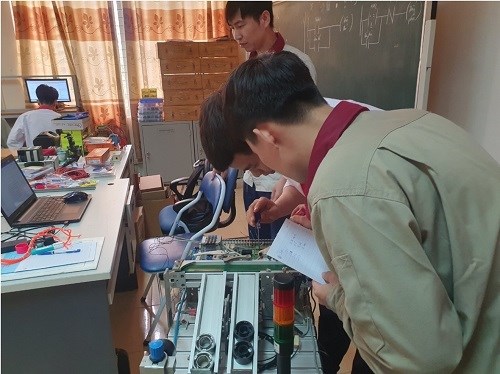In the process of restructuring the national education system, the restoration of the Vocational College (VCC) level is considered a strategic solution to implement the diversion of post-graduate education (PET) in a practical way. This model hopes to integrate core cultural education with vocational training, helping learners shorten their time, participate in the labor market early and still have opportunities to continue learning thanks to a flexible interconnection mechanism.
On June 26, the Ministry of Education and Training (MOET) announced the draft Law on Vocational Education (amended) on the Ministry's Electronic Information Portal to collect comments according to regulations.
Contributing to the Draft, some opinions suggested: Allowing junior high school students to study a few additional cultural subjects to take the high school graduation exam. It sounds reasonable - "creating more options" - but in fact reflects the deep-level thinking, going against the goal of decentralization - education flow, causing many consequences in terms of institutions, quality and social orientation.
Da Nang will fail if the target is blurred
The policy of traffic diversion after secondary school is to develop a multi-road educational system, suitable for learners' abilities. Accordingly, high school oriented academically; junior high school follows the career - application direction, helping learners have practical skills and a suitable learning path.

If we let junior high school students take the high school graduation exam by studying only a few subjects, the flow of the exam will be softed that it will be blurred. The flow is no longer a clear orientation but becomes a way to go around and then return to the starting point: study to take the exam, take the exam to get a degree.
At that time, THN was deformed into a "professional" high school version, no longer having its own identity, no longer creating a different learning path. This allocation is only a form, not solving the real problem that Vietnamese education is facing.
Controversy over the design of a culture - vocation integration program
Circular 15/2022/TT-BGDDT stipulates a shortened cultural program for junior high school graduates to enter secondary school. The goal is to equip the minimum general education foundation, serving continuing education and working citizens. However, the content is still quite heavy and not optimized in the direction of linking vocational capacity as many European or Korean countries are implementing.
The THN model only retains core cultural subjects - Math, Literature, Foreign Language, Civic Education, Information Technology... - deep and wide enough to directly integrate with vocational training. This helps save time, making the learning content close, practical, and making learning as much as possible. When it is necessary to study further, additional cultural credits can be added in an open direction, suitable for the major.
If we follow the proposal to study a few more subjects such as History, Geography, Chemistry... to take the high school graduation exam, the entire meaning of integrating careers - culture and saving time will be broken. The school must adjust the time and reduce vocational practice. Students fall into spread-out learning, learning for exams - instead of practicing clear professional skills.
"3 years - 2 degrees": thought attractive but a trap
The proposal for junior high school students to study a trade and take the high school graduation exam in 3 years is actually a "combo" of 2 in 1. It sounds attractive, but not feasible and unreasonable.
If there is no increase in time, no clear separation of programs, no separate roadmap, then "2 degrees" is just a form. Students will be overloaded, while their teaching capacity, facilities and career orientation are fading.
The result is: a professional degree is not practical; a high school diploma also does not accurately reflect the ability - because currently only 4 subjects are required, considering 50% of academic records, the graduation rate is always over 98%. The THN model was "destroyed", becoming a "copy" of high school, failing to maintain its original value.
graduate thinking - the biggest barrier
The above proposal does not come from the need to learn real abilities but from the popular psychology of degrees. Many parents do not want their children to " learn a trade", afraid of not having a high school diploma. But if the legal system follows, the educational institution will be distorted.
Flow allocation is only effective when the routes are different - but all have the same value. Both high school and high school degrees should be recognized equally for continued study, employment and development. Do not combine everything in one formal graduation exam.
Clear legalization is needed to avoid bienulture
To protect the superiority of the VBSP model and maintain traffic flow - layering in national education, there needs to be a clear and consistent legal framework. First of all, it is necessary to affirm that VNU and high school are two roadmaps with equal legal value in terms of continued learning rights, employment and career development, but different in program content, training methods and results assessment.
Therefore, junior high school students should only be allowed to take the high school graduation exam if they have studied the full-time high school program. In case learners need to get two degrees - vocational and high school - they must follow a separate roadmap of at least 4 years, according to a dual-track model, with clear time allocation, strict professional guidance and not generally phoised.
At the same time, it is necessary to design a transparent inter-bank mechanism from junior high school to college and university, based on assessment of professional competence combined with integrated education, not requiring a high school diploma and adding necessary cultural subjects to study. Along with that is social media to enhance the value of skills, affirming that vocational training is an official roadmap, recognized and guaranteed to be on par with cultural learning in the open and modern education system.
Allowing junior high school students to take the high school graduation exam by studying only a few subjects outside the integrated program is a reasonable wish but has many risks. It erodes the core value of the model - designed to save time, develop skills and expand learning options - not to legalize degrees.
Innovation in the education system cannot continue to run for degrees. A new model cannot be built on the foundation of old expectations. If not decisive, THN will be converted into high school due to the need for high school. More importantly, we will miss the opportunity to create institutional breakthroughs, build a modern, flexible, personalized education system - as many advanced countries have done. It is time for a clear vision: instead of chasing the name of a degree, focus on the real abilities that learners achieve. This is completely consistent with the spirit of NQ 29 on converting heavy training in content to capacity development training.











